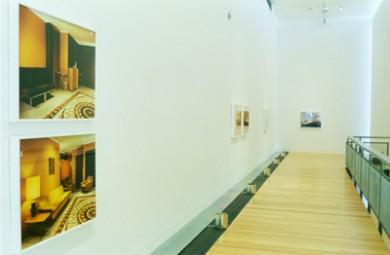Ann Shelton: Abigail’s Party
13 May - 11 June 2000
Ann Shelton’s photographs at first appear to be part of the documentary residue of New Zealand’s experience of modernism. However, belying their appearance as ‘real’ modernist interiors, Shelton’s six scenes were staged at her home in Auckland. Here Shelton constructed interiors not to be lived in, but to be photographed. Thus her photographs are deliberately constructed ‘fakes’.
In reconstructing the past, Abigail’s Party was a reminder of the penchant for retro styling, in which 1950s type furniture or design is adopted by the fashion-conscious of today. However, this retro revisiting only borrows the modernist style, neglecting the aims or theories of the movement–these may instead be thrown into question.
The gap between modernism’s retrospective appreciation and its original sensibility is demonstrated in the used, second-hand objects that Shelton photographs. As a movement, modernism was concerned with the truly up to date, the new, the modern. However, Shelton’s worn objects themselves exhibit a past, marking them as having been part of lifestyles that are now seen through the lens of a contemporary reverie.
Shelton’s works raise a question key to the fate of modernism–what happens when the modern becomes old? Modernism is now located within a unique and difficult position–this movement, so utterly concerned with rejecting tradition and being contemporary, is now itself consigned to ‘history’. Photography has played a role in this. As modernism has entered history, the experience of it has been mostly through the realm of documentary photographs. Thus we know modernism only as a surface experience–we know the style, but none of its context.
Shelton hints at the difference between her images and the ‘real thing’, through her use of colour. While documentary photographs of modernist design are usually black and white, Shelton’s works are full, vibrant colour.
Through reconstructing modernism, Shelton also has the opportunity to rewrite its history, and she does so with a feminist twist. Her use of luscious, juicy colours, tactile fabric, domestic settings, and titles such as Calendar Girl, Golden Girl or Show Girl, feminise and sexualise these modernist spaces.
The time at which modernism was reaching its height preceded the effects of the sexual revolution and women’s liberation. Modernism remained a male dominated style within a male dominated world. However, Shelton’s works pastiche this style in order to insert women (and women’s sexuality) into a period of (art) history in where they were previously absent.
Although inhabitants never appear in Abigail’s Party, they are hinted at. There is a humanity and personality in Shelton’s photos that is missing in many photographs of modernist architecture and interior design where languid models appeared.
Shelton’s works may be taken as a starting point for many issues. They may be seen as an example of activating modernism. Or they may address ways of experiencing modernism today. They may also challenge the positioning of women in art and history. All are possible.
Ingrid Neilson.



